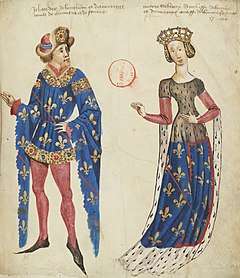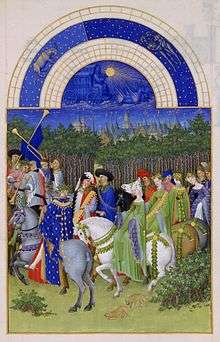Marie, Duchess of Auvergne
Marie of Berry (c. 1375 – June 1434) was suo jure Duchess of Auvergne and Countess of Montpensier in 1416-1434. She was the daughter of John, Duke of Berry, and Joanna of Armagnac. She was married three times. She acted as administrator of the Duchy of Bourbon for her third spouse John I, Duke of Bourbon, during his imprisonment in England after he was captured following the French defeat at the Battle of Agincourt in 1415, until 1434.
| Marie of Berry | |
|---|---|
| Duchess of Auvergne Countess of Montpensier | |
 Marie of Berry and her third husband John of Bourbon. Guillaume Revel, Armorial d'Auvergne: BNF Français 22297 f. 17r | |
| Born | c. 1375 |
| Died | June 1434 Lyon |
| Burial | Priory of Souvigny |
| Spouse | |
| Issue more... | |
| House | Valois-Berry |
| Father | John, Duke of Berry |
| Mother | Joanna of Armagnac |
- Not to be confused with Marie I, Countess of Auvergne
Life
Marie was born about the year 1375,[1][2] the youngest daughter of John "the Magnificent", Duke of Berry and Joanna of Armagnac. Through her father, a great collector of antiquities, art patron and bibliophile, she was a granddaughter of King John II of France. She had three brothers, Charles, Louis, and John; and one older sister, Bonne.


Countess consort of Châtillon
The first of Marie's three marriages[3] took place on 29 May 1386 in the Cathedral of Saint-Etienne at Bourges: aged about 11, Marie married Louis III de Châtillon as her first husband. Marie's father gave her a dowry of 70,000 francs; he gave Louis, his son-in-law, the county of Dunois.[4] The marriage and trousseau had been arranged by the two fathers in 1384: "A Duke will dress her, in bed and out of it, and a Count will put the jewels on her", John Duke of Berry and Guy Count de Blois-Châtillon agreed. The festivities at the wedding de ces jeunes enfants ("of these young children") are described in Jean Froissart's Chronicles.[5]
Countess of Eu
There were no children from this marriage, and Louis died on 15 July 1391. On 27 January 1393 a marriage contract was drawn up for Marie and Philip of Artois, Count of Eu. They were married the next month at the Palais du Louvre in Paris; King Charles VI of France himself paid for the festivities, while her father gave her a dowry of 70,000 francs. They had two sons and two daughters. The King appointed Philip Constable in 1392. Philippe went on Crusade and fought alongside his friend Jean Le Maingre ("Boucicaut"), marshal of France at the disastrous Battle of Nicopolis on 25 September 1396. Both were captured, and Philip died some months later in captivity at Micalizo, now called Mihalıççık, in western Turkey.[6]
After Philippe's death inter Sarracenos ("among the Saracens"), his body was brought back to Eu, his home town, and Marie gave an endowment of £100 annually to the Collegial Church of Notre-Dame-et-Saint-Laurent for a mass to be celebrated there on 17 June each year in his memory.[7] Their eldest son, Philippe, died on 23 December in the same year and is also buried in Eu.[8] Jointly with her widowed sister-in-law, Jeanne of Thouars, Marie was appointed guardian of the three surviving children of her marriage with Philippe: Charles, Bonne and Catherine. Aged about three, Charles succeeded his father as Count of Eu. His revenues were held for him until he came of age by three trustees: Marie herself, her father, and her uncle Philip the Bold, Duke of Burgundy.[1]
Duchess consort of Bourbon
Marie married her third husband John of Bourbon at the "King's Palace" (the Palais de la Cité) in Paris on 21 June 1401. The contract had been signed at Paris on 27 May 1400 after complex negotiations.[9][10] She bore him three children.[11] He was appointed Grand Chamberlain of France on 18 March 1408 and succeeded his father as Duke of Bourbon on 19 August 1410. Marie's father had persuaded King Charles VI not to fight at the battle of Agincourt on 25 October 1415, but Marie's husband did fight, was captured, and spent the rest of his life in English captivity.
Marie is believed to be depicted in one or possibly two full-page miniatures in the Très Riches Heures du Duc de Berry, a lavishly-illustrated manuscript made for her father in the years after his sons' deaths. In the illustration for the month of April, the young noblemen and women in the foreground are grouped around a couple agreeing to be married. According to Patricia Stirnemann, referencing Saint-Jean Boudin, the scene, although not painted until about 1410, depicts the engagement of Marie with John of Bourbon in 1401.[12] Raymond Cazelles disputes this, arguing that the couple are Marie's niece Bonne of Armagnac and Charles, Duke of Orléans, who were to marry in 1411.[13] A May Day celebration among nobles takes place in the foreground of the illustration for the month of May. Details appear to confirm that the house of Bourbon is represented.[14] Both Cazelles and Stirnemann believe that the woman seen in the foreground, riding on a white horse and wearing a large white headdress, is Marie on the occasion of her marriage on 21 June 1401. These scholars do not agree as to which of the accompanying men is John of Bourbon.[12][13] The buildings in the background have been variously identified, but G. Papertiant suggests that they are the Châtelet, Conciergerie and Tour de l'Horloge in Paris, and at the centre the Palais de la Cité where Marie's wedding took place.[15]
A manuscript made for Marie's own use and presented to her in 1406 survives today as BnF, fr. 926. It is a short collection of Christian devotional works, beginning with Bonaventure's Stimulus amoris, translated into French by Simon de Courcy as the Traitieé de l'esguillon d'amour divine. It includes a miniature of Marie and her daughter Bonne (aged about ten at this time) kneeling in prayer before the Virgin Mary.[16] The manuscript is now in the Bibliothèque nationale de France.[17] Marie also selected approximately 40 manuscripts from among her father's collection on his death, as she was still owed the 70,000 franc dowry from her second marriage.[18]
Duchess of Auvergne and Countess of Montpensier
All three of Marie's brothers were dead before 1400,[19] which explains the complexity of the negotiations for her third marriage: she and her elder sister Bonne were to be heirs to John of Berry's titles, which required royal assent.[9][20] John of Berry died on 15 June 1416 (by which time Marie's husband was already a prisoner in England). Marie was accordingly appointed Duchess of Auvergne and Countess of Montpensier on 26 April 1418; these titles were confirmed in 1425. On 17 January 1421, her husband appointed her administrator of his estates as well.[8] He died a prisoner in London in January 1434.[11] Marie died in Lyon on an unknown date in June of the same year. She was buried at Souvigny Priory.[8]
Family
- Louis III de Châtillon
- Philip of Artois, Count of Eu (1358 –1397)
- Philippe (died 23 December 1397)
- Charles of Artois, Count of Eu (c. 1394 –1472)
- Bonne (1396 –1425), who married firstly Philip Count of Nevers (1389 –1415), youngest son of Philip the Bold, Duke of Burgundy; and secondly Philip the Good, Duke of Burgundy (1396 –1467).
- Catherine (1397 –1422?), who married John of Bourbon, Lord of Carency.
- John I, Duke of Bourbon
- Charles I, Duke of Bourbon (1401 –1456)
- Louis (1403 –1412, Paris), Count of Forez
- Louis I, Count of Montpensier (1405 –1486)
Notes
- Autrand 2000, p. : section "Marie"
- Jean Froissart, Chronicles calls her a "child" when she first married in 1386 (citation to verify) and estimates that she was "about 23" when her second spouse Philippe of Artois died in 1397 (Froissart & Brereton 1968, p. 439)
- Froissart & Brereton 1968, p. 439.
- Autrand 2000, p. : section "Marie" and footnotes 357-358
- Froissart & Brereton 1968, p. .
- Reynaud 1905, pp. li-lii.
- Recueil des historiens des Gaules et de la France,vol. 23 (1894) p. 450 "Ex obituario ecclesiae Augensis"
- Cawley 2011, Marie Berry died 1434.
- Anselme 1700, p. 137
- Autrand 2000, p. : section "Marie" and footnote 359
- Cawley 2011b, Jean I Duc died 1434.
- Stirnemann & Villela-Petit 2004, pp. 40–43
- Cazelles & Rathofer 2001, p. 26
- Hablot 2001, pp. 91–103
- Papertiant 1952, pp. 52-58.
- Marrow 1996, pp. 103-104 and fig. 8.
- Catalogue entry and microfilm reproduction
- Beaune & Lequain 2007, p. 49
- Cawley 2011c, Jean de Berry and footnote 799 remarks on an inconsistency by P. van Kerrebrouck, who in his Les Valois (1990) p. 261 states that John died after his father, i.e. in 1416 or after, but in his La Maison de Bourbon: 1256-1987 (1987) p. 91 gives John's date of death as 1399. Cawley adds further evidence that John died before his father.
- Autrand 2000, p. :section "Marie" and footnotes 360-361
References
- Anselme, Père (1700). Histoire généalogique et chronologique de la maison royale de France (in French). 3. Paris. p. 137.CS1 maint: ref=harv (link)
- Autrand, Françoise (2000). Jean de Berry (in French). Paris: Fayard. ISBN 9782213648156.CS1 maint: ref=harv (link)
- Beaune, Colette; Lequain, Élodie (2007). "Marie de Berry et les livres". In Legaré, Anne-Marie (ed.). Livres et lectures de femmes en Europe entre Moyen Âge et Renaissance (in French). Turnhout: Brepols. pp. 49–66.CS1 maint: ref=harv (link)
- Cawley, Charles (26 February 2011), France Capetian kings: Marie de Berry, Medieval Lands database, Foundation for Medieval Genealogy
- Cawley, Charles (7 February 2011b), Bourbon: Jean I Duc died 1434, Medieval Lands database, Foundation for Medieval Genealogy
- Cawley, Charles (26 February 2011c), France Capetian kings: Jean de Berry, Medieval Lands database, Foundation for Medieval Genealogy
- Froissart, Jean; Brereton, Geoffrey (translator) (1968). Chronicles. Harmondsworth. p. 439.CS1 maint: ref=harv (link)
- Cazelles, Raymond; Rathofer, Johannes (2001). Les Très Riches Heures du Duc de Berry (in French). Tournai: Renaissance du Livre. p. 26. ISBN 2-8046-0582-5.CS1 maint: ref=harv (link)
- Hablot, Laurent (2001). "La ceinture Espérance et les devises des ducs de Bourbons". In Perrot, F. (ed.). Espérance, le mécénat religieux des ducs de Bourbon au XVe siècle (in French). Souvigny. pp. 91–103.CS1 maint: ref=harv (link)
- Marrow, James H. (1996). "Art and Experience in Dutch Manuscript Illumination around 1400: Transcending the Boundaries". Journal of the Walters Art Gallery. 54: 101–117.CS1 maint: ref=harv (link)
- Papertiant, G. (1952). "Note sur les Très Riches Heures du duc de Berry". Revue des Arts (in French). 2: 52–58.CS1 maint: ref=harv (link)
- Reynaud, Gaston, ed. (1905). Les cent ballades (in French). Paris. pp. li–lii.CS1 maint: ref=harv (link)
- Stirnemann, Patricia; Villela-Petit, Inès (2004). Les Très Riches Heures du duc de Berry et l'enluminure en France au début du XVe siècle (in French). Paris: Somogy. pp. 40–43. ISBN 2850567426.CS1 maint: ref=harv (link)
External links
- Bonaventure, Aiguillon d'amour: microfilm reproduction of the manuscript presented to Marie de Berry c. 1406 (Bibliothèque nationale de France)